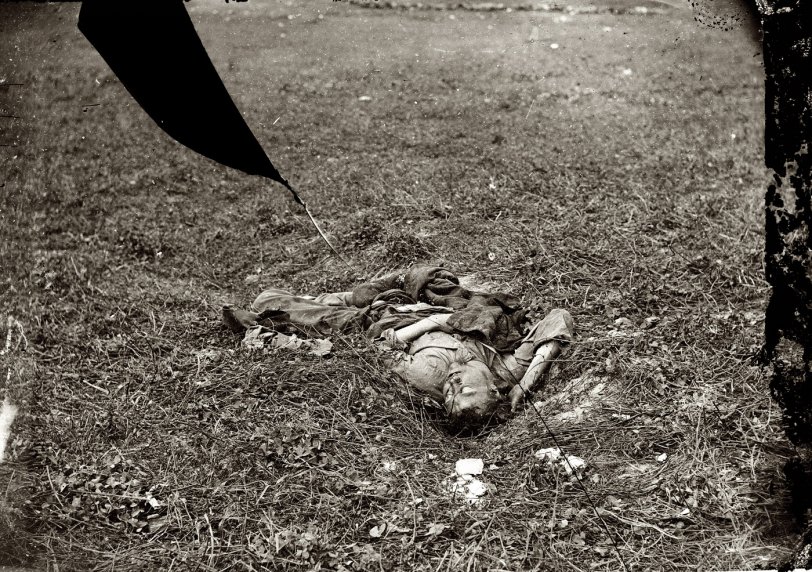


Framed or unframed, desk size to sofa size, printed by us in Arizona and Alabama since 2007. Explore now.
Shorpy is funded by you. Patreon contributors get an ad-free experience.
Learn more.

- Tough Guys
- Lost in Toyland
- And without gloves
- If I were a blindfolded time traveler
- Smoke Consumer Also Cooks
- Oh that stove!
- Possibly still there?
- What?!?
- $100 Reward
- Freeze Frame
- Texas Flyer wanted
- Just a Year Too Soon
- WWII -- Replacing men with women at the railroad crossing.
- Yes, Icing
- You kids drive me nuts!
- NOT An Easy Job
- I wonder
- Just add window boxes
- Icing Platform?
- Indiana Harbor Belt abides
- Freezing haze
- Corrections (for those who care)
- C&NW at Nelson
- Fallen Flags
- A dangerous job made worse
- Water Stop
- Passenger trains have right of way over freights?
- Coal
- Never ceases to amaze me.
- Still chuggin' (in model form)
Print Emporium
Antietam: 1862

September 1862. Antietam, Maryland. "Confederate soldier who after being wounded had evidently dragged himself to a little ravine on the hillside where he died." Wet plate glass negative by Alexander Gardner. View full size.
I always think of their mothers
I have seen pictures of young men dead from war as some mother's son for many years, but even more so, since the death of my own son. My son's death didn't help to preserve democracy, or anything like that, though. I guess you could say he died in the war on drugs, making him one more among the millions of young people who have died of accidental drug overdoses.
Sacrifice at Sharpsburg
Dulce et decorum est pro patria mori.
Brady's negatives
Brady's negatives were sold to the E. & H. T. Anthony Company during the wartime period. The Anthony Company later sold those negatives to Frederick Hill Meserve around 1900, and Meserve's family sold many of them to the Smithsonian in 1981. Brady sold another set of negatives directly to the government in 1875.
Glass plates
I understand that Mathew Brady died a poor man even after selling most of his plates to people building greenhouses. It makes me sick to think how much history was lost, fading away in the sun for the sake of growing a few tomatoes.
Confederate Photographers
"Why is it,that whenever you see a Dead Soldier from the Civil War, just about 95% of the time it is always a Confederate soldier?"
Dave gives one explanation - that the photographers were traveling with the Union Army. But there is a secondary explanation. As I understand it photographers in the Confederacy had considerable difficulty in acquiring the chemicals they needed. Many of those chemicals would need to be imported on blockade runners (or smuggled in from the North) and obviously the South had more pressing needs (like medicine), and the blockade runners were more likely to want to bring in higher value and more compact goods. That, combined with the demand for portraits, kept most Confederate photographers in the studios.
Confederate soldier
Why is it,that whenever you see a Dead Soldier from the Civil War, just about 95% of the time it is always a Confederate soldier??
[Because the photographers are traveling with the Union Army, on ground taken by the North. Whose dead are more likely to have been cleared from the field. And I'd say it's more like 70-30. - Dave]
Little Ravine
Something about that term "little" ravine makes the description even sadder.
Some Mother's Son
Someone's dear boy, dead in a field, as boys always are when war sweeps them up.
Speechless
There are no words to describe how this picture made me feel- I will say, I wonder if/when someone will be struck dumb by a picture of a dead soldier from our current war...it's incredibly sad.
Civil War photos
Apparently there were so many photos taken during the Civil War that the demand for them lowered considerably, especially those of dead soldiers. The glass plates found other uses such as windowpanes for greenhouses. I always find it rather amazing that any were left for producing later.
Sharpsburg
Though men deserve, they may not win, success;
The brave will honor the brave, vanquished none the less.
























On Shorpy:
Today’s Top 5